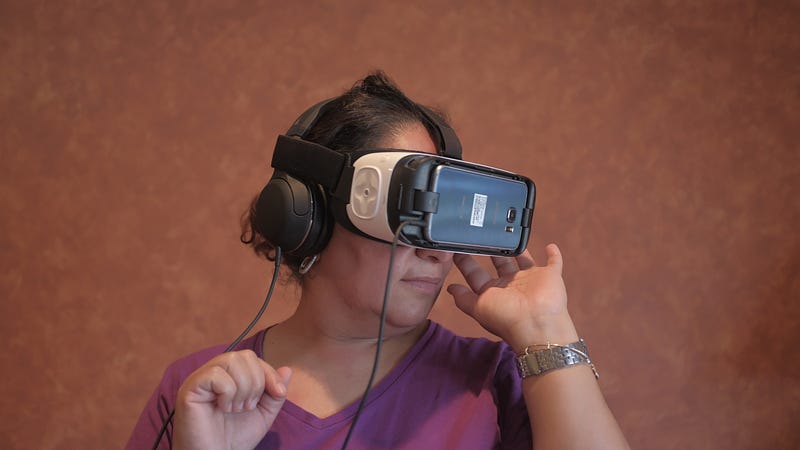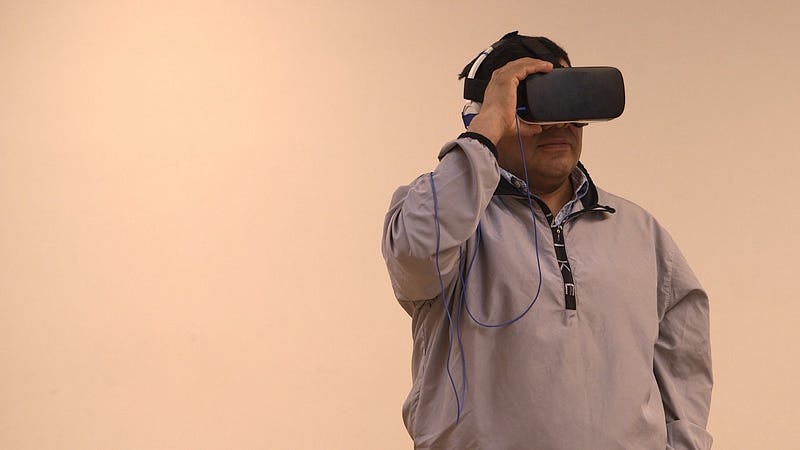Who Is VR For? Maybe for Me and My Mom
An Immerse response
I’d like to start by saying that my intention in writing a response to Ingrid Kopp’s piece, Who Is VR For?, is to build on her points based on my personal experience.
 The Family
Reunions Project (FRP) is an initiative exploring how technology can challenge borders and reshape
the way we think of immigrants’ transnational lives.
The Family
Reunions Project (FRP) is an initiative exploring how technology can challenge borders and reshape
the way we think of immigrants’ transnational lives.I’ve always been fascinated by the intersection of film, tech, and migration. And, being undocumented, my experience with technology has always been different than most.
I remember the first few times my family Skyped back home to Guatemala. It was a thrilling experience to be able to see my mom look at my grandma’s face on the computer, no longer having to pay for long-distance calling cards to only have a few minutes to talk. We were lucky that my grandparents had internet, our own virtual connection.
“Let me see the house,” my mom would ask.
She missed home, but we couldn’t go back — not with our immigration status. So the calling cards and Skype continued, the only accessible thing to us that could defy borders.
I had been creating short films and videos for some time and became inspired to explore VR after sneaking my way into the Interactive day at the Tribeca Film Festival. Knowing my passion for media and storytelling, our friends at the New York State Youth Leadership Council (NYSYLC), an undocumented youth-led organization, connected me to Alvaro Morales, the co-founder of what would become the Families Reunion Project (FRP). We both shared an interest in VR and had immigration on our mind.
What if we “transport” families back home using VR and 360 video? Alvaro proposed.
His idea instantly made me think of my mother. I asked my parents if they would like to be the first family to try it out. In a matter of days, my mother found a video producer with a 360 camera in Guatemala to film the first “VR Postcard.” We call them “VR postcards” because they were pre-recorded messages that are sent across borders. Using some of my savings, we recorded, edited and produced our first “virtual reunion”
The first reunion instantly showed us just how powerful this medium could be.
My mother was able to see the house we left behind. She was able to see her old school, her friends, and her grandfather and his house, a place she wasn’t allowed to visit as a child.
My father instantly felt transported to the street where he used to hang out. His friends greeted him extending their hands towards the camera and my father extended the gesture back.
The experiences were emotional to say the least. I asked my parents afterwards how they felt; my dad, maybe hiding emotions, said that he felt happy and with more strength to continue the fight.
My mother, on the other hand, said that she wanted to go back.
Obstacles and opportunities
When Alvaro and I first talked, we didn’t have any funding. Neither of us owned any equipment for this kind of project, and we were both unable to leave the U.S. In retrospect, we faced many of the same issues around accessibility that Ingrid notes in her piece, and at least for me, a few others as well.
I could have benefited from finishing college. Even though I went for a year, I had to drop out to work full-time in support of my family. My lack of access to learning spaces and opportunities to practice and improve my writing skills became noticeable when I had to write grant applications, briefs, bios, artist statements, and even emails.
My financial situation prevented me from taking risks such as working on a visual project full-time, and my fear of deportation didn’t help either. These factors even affected my involvement in the very project I co-founded.
However, in some ways, I have also had significant access to tools by living in New York City. My relationship with TFI’s youth programs and my high school education from the Academy for Careers in TV and Film exposed me to people, skills, and knowledge that have been integral in my personal and professional development.
Outside of institutions, it’s been my friends who have helped me write, navigate application processes, or even just share advice. It’s been my community that has snuck me into spaces (like Blue Ridge Labs and TFI’s Interactive day) and has been committed to pushing for my presence there.
It was our community of friends, family, and supporters who helped us create FRP.
Around the same time of my family’s virtual reunion, we got some good news. E4FC, an organization that provides incredible support to undocumented people, created a grant specifically for undocumented entrepreneurs, and we were one of six to receive it. The grant is essential in ensuring marginalized people (in this case undocumented) have opportunities to kickstart their ideas.
Our past connections and networks became the friends who helped us out during our production, friends who volunteered their time to help stitch, shoot, and edit with us. Even family members that had no prior experience in media became great producers as we created the postcards.
The NYSYLC supported FRP by using their network of members to help find families for the reunions. In some cases, their space even became our place of “virtual reunions.”
Truthfully, our community showed up in the best way they could.
 A man from
Chalco, Mexico visiting the street where he grew up.
A man from
Chalco, Mexico visiting the street where he grew up.Centering communities
I don’t know how to solve the systemic problems around accessibility. I can talk about redistributing funding within the art world and rethinking programs and applications that continue to uphold white supremacy, but I just got here…and I just entered this conversation. I think the first step involves bringing more people from communities affected by oppressive systems into conversations.
Organizations such as Culturestrike are focusing their events on bringing together “cultural gatekeepers to translate intentions of solidarity into institutional practice.” This means creating spaces where artists from migrant, queer communities, and gatekeepers discuss inequities in the art world.
TFI did the same last week during its inclusion council. The council, led by Detroit Narrative Agency, discussed different practices and models around gender and racial equity. We talked about generating programming from within the community rather than leaving it to outsiders.
These models of conversations, where we center the communities we are hoping to bring into the space, are essential to replicate. The people who have been fighting for access are the ones who should speak on behalf of the change they want to see. By doing this, we uplift and acknowledge the power of each community.
 After
Alvaro’s massive undertaking, the FRP has taken on over 12 virtual reunions. A few of these reunions
were filmed by the families themselves using small 360 video kits we provided.
After
Alvaro’s massive undertaking, the FRP has taken on over 12 virtual reunions. A few of these reunions
were filmed by the families themselves using small 360 video kits we provided.I’ve seen the impact of community support and meaningful conversations with the FRP.
Soon after E4FC’s initial funding, the FRP received further funding from TFI and CultureStrike. The collection of these grants allowed us to continue working on the project — meaning we would have enough money to travel, edit, buy equipment and, most importantly, continue to create more experiences for families.
As we push the boundaries and uses of new mediums, I keep thinking back to my family and my mom. I’m happy that we got the chance to play with the medium, and fortunate that my mother was able to experience something that transcended borders.
Maybe VR is for me to imagine, maybe it’s for my mom to relive, maybe it’s for healing, for memories, for ourselves. We may never know what VR is for unless we continue to bring new voices into the field.
I’m thankful for all the work and support our communities have put in for the project and our vision. Our community of friends knew long-term investment went a long way.
I wanted to give a few thanks to the people who helped us along the way: Maria Fernanda Andia, for helping me write and edit this response. To NYSYLC, Lupe, Diana, Angy, who got us together and saw the potential. To Sonia, Favianna, and the team from CultureStrike. Our friends at E4FC, the Tribeca Film Institute, FIRME, who continue to do amazing work. DNA, who I met last week, for facilitating such a great conversation.
To Ingrid and Immerse for waiting so long for me to finish this.
and to my family, and my Mother, who continue to inspire me every day.
Immerse is an initiative of Tribeca Film Institute, MIT Open DocLab and The Fledgling Fund. Learn more about the project here.